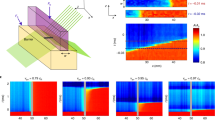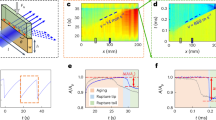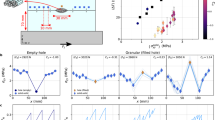Abstract
Frictional motion is mediated by rapidly propagating ruptures that detach the ensemble of contacts forming the frictional interface between contacting bodies1,2,3,4,5,6,7. These ruptures are similar to shear cracks. When this process takes place in natural faults, these rapid ruptures are essentially earthquakes8,9. Although fracture mechanics describe the rapid motion of these singular objects, the nucleation process that creates them is not understood10,11,12,13,14,15,16,17,18,19. Here we fully describe the nucleation process by extending fracture mechanics to explicitly incorporate finite interface widths (which are generally ignored20,21). We show, experimentally and theoretically, that slow steady creep ensues at a well-defined stress threshold. Moreover, as slowly creeping patches approach the interface width, a topological transition takes place in which these creeping patches smoothly transition to the rapid fracture that is described by classical fracture mechanics22,23,24,25,26. Apart from its relevance to fracture and material strength, this new picture of rupture nucleation dynamics is directly relevant to earthquake nucleation dynamics; slow, aseismic rupture must always precede rapid seismic rupture (so long as the initial defect in the interface is localized in both spatial dimensions). The theory may provide a new framework for understanding how and when earthquakes nucleate.
This is a preview of subscription content, access via your institution
Access options
Access Nature and 54 other Nature Portfolio journals
Get Nature+, our best-value online-access subscription
$32.99 / 30 days
cancel any time
Subscribe to this journal
Receive 51 print issues and online access
$199.00 per year
only $3.90 per issue
Buy this article
- Purchase on SpringerLink
- Instant access to full article PDF
Prices may be subject to local taxes which are calculated during checkout




Similar content being viewed by others
Data availability
The raw data (camera recordings and strain gauge measurements) for all events analysed in this paper can be accessed directly at https://doi.org/10.4121/12631fa1-4fed-440d-acf3-676b97862034. More information and other findings of this study are available from the corresponding author upon request. Source data are provided with this paper.
References
Rubinstein, S. M., Cohen, G. & Fineberg, J. Detachment fronts and the onset of dynamic friction. Nature 430, 1005–1009 (2004).
Xia, K., Rosakis, A. J. & Kanamori, H. Laboratory earthquakes: the sub-Rayleigh-to-supershear rupture transition. Science 303, 1859–1861 (2004).
Passelègue, F. X. et al. Initial effective stress controls the nature of earthquakes. Nat. Commun. 11, 5132 (2020).
Schubnel, A., Nielsen, S., Taddeucci, J., Vinciguerra, S. & Rao, S. Photo-acoustic study of subshear and supershear ruptures in the laboratory. Earth Planet. Sci. Lett. 308, 424–432 (2011).
Svetlizky, I. & Fineberg, J. Classical shear cracks drive the onset of dry frictional motion. Nature 509, 205–208 (2014).
Wu, B. S. & McLaskey, G. C. Contained laboratory earthquakes ranging from slow to fast. J. Geophys. Res. Solid Earth 124, 10270–10291 (2019).
Xu, S., Fukuyama, E. & Yamashita, F. Robust estimation of rupture properties at propagating front of laboratory earthquakes. J. Geophys. Res. Solid Earth 124, 766–787 (2019).
Byerlee, J. D. & Brace, W. F. Stick slip, stable sliding, and earthquakes-effect of rock type, pressure, strain rate, and stiffness. J. Geophys. Res. 73, 6031–6037 (1968).
Scholz, C. H. The Mechanics of Earthquakes and Faulting 3rd edn (Cambridge Univ. Press, 2019).
Ohnaka, M. & Shen, L.-F. Scaling of the shear rupture process from nucleation to dynamic propagation: Implications of geometric irregularity of the rupturing surfaces. J. Geophys. Res. Solid Earth 104, 817–844 (1999).
Latour, S., Schubnel, A., Nielsen, S., Madariaga, R. & Vinciguerra, S. Characterization of nucleation during laboratory earthquakes. Geophys. Res. Lett. 40, 5064–5069 (2013).
Dresen, G., Kwiatek, G., Goebel, T. & Ben-Zion, Y. Seismic and aseismic preparatory processes before large stick-slip failure. Pure Appl. Geophys. 177, 5741–5760 (2020).
Popov, V. L., Grzemba, B., Starcevic, J. & Fabry, C. Accelerated creep as a precursor of friction instability and earthquake prediction. Phys. Mesomech. 13, 283–291 (2010).
Lapusta, N. & Rice, J. R. Nucleation and early seismic propagation of small and large events in a crustal earthquake model. J. Geophys. Res. Solid Earth 108, 2205 (2003).
Uenishi, K. & Rice, J. R. Universal nucleation length for slip-weakening rupture instability under nonuniform fault loading. J. Geophys. Res. Solid Earth 108, 2042 (2003).
Hulbert, C. et al. Similarity of fast and slow earthquakes illuminated by machine learning. Nat. Geosci. 12, 69–74 (2019).
Leeman, J. R., Marone, C. & Saffer, D. M. Frictional mechanics of slow earthquakes. J. Geophys. Res. Solid Earth 123, 7931–7949 (2018).
Gvirtzman, S. & Fineberg, J. Nucleation fronts ignite the interface rupture that initiates frictional motion. Nat. Phys. 17, 1037–1042 (2021).
Gvirtzman, S. & Fineberg, J. The initiation of frictional motion–the nucleation dynamics of frictional ruptures. J. Geophys. Res. Solid Earth 128, e2022JB025483 (2023).
Weng, H. & Ampuero, J.-P. The dynamics of elongated earthquake ruptures. J. Geophys. Res. Solid Earth 124, 8584–8610 (2019).
Weng, H. & Ampuero, J.-P. Integrated rupture mechanics for slow slip events and earthquakes. Nat. Commun. 13, 7327 (2022).
Freund, L. B. Dynamic Fracture Mechanics (Cambridge Univ. Press, 1998).
Broberg, K. B. Cracks and Fracture (Academic Press, 1999).
Palmer, A. C. & Rice, J. R. The growth of slip surfaces in the progressive failure of over-consolidated clay. Proc. R. Soc. Lond. A 332, 527–548 (1973).
Barras, F. et al. Emergence of cracklike behavior of frictional rupture: The origin of stress drops. Phys. Rev. X 9, 041043 (2019).
Barras, F. et al. The emergence of crack-like behavior of frictional rupture: Edge singularity and energy balance. Earth Planet. Sci. Lett. 531, 115978 (2020).
Kostrov, B. Selfsimilar problems of propagation of shear cracks. J. Appl. Math Mech. 28, 1077–1087 (1964).
Kanamori, H. & Brodsky, E. E. The physics of earthquakes. Rep. Prog. Phys. 67, 1429–1498 (2004).
Viesca, R. C. & Garagash, D. I. Ubiquitous weakening of faults due to thermal pressurization. Nat. Geosci. 8, 875–879 (2015).
Mello, M., Bhat, H. S. & Rosakis, A. J. Spatiotemporal properties of Sub-Rayleigh and supershear rupture velocity fields: Theory and experiments. J. Mech. Phys. Solids 93, 153–181 (2016).
Svetlizky, I., Kammer, D. S., Bayart, E., Cohen, G. & Fineberg, J. Brittle fracture theory predicts the equation of motion of frictional rupture fronts. Phys. Rev. Lett. 118, 125501 (2017).
Kammer, D. S., Svetlizky, I., Cohen, G. & Fineberg, J. The equation of motion for supershear frictional rupture fronts. Sci. Adv. 4, eaat5622 (2018).
Bayart, E., Svetlizky, I. & Fineberg, J. Fracture mechanics determine the lengths of interface ruptures that mediate frictional motion. Nat. Phys. 12, 166–170 (2016).
Bayart, E., Svetlizky, I. & Fineberg, J. Rupture dynamics of heterogeneous frictional interfaces. J. Geophys. Res. Solid Earth 123, 3828–3848 (2018).
Paglialunga, F., Passelègue, F., Lebihain, M. & Violay, M. Frictional weakening leads to unconventional singularities during dynamic rupture propagation. Earth Planet. Sci. Lett. 626, 118550 (2024).
Brener, E. A. & Bouchbinder, E. Unconventional singularities and energy balance in frictional rupture. Nat. Commun. 12, 2585 (2021).
Ben-David, O., Cohen, G. & Fineberg, J. The dynamics of the onset of frictional slip. Science 330, 211–214 (2010).
Gori, M., Rubino, V., Rosakis, A. J. & Lapusta, N. Dynamic rupture initiation and propagation in a fluid-injection laboratory setup with diagnostics across multiple temporal scales. Proc. Natl Acad. Sci. USA 118, e2023433118 (2021).
Marone, C. in The Spectrum of Fault Slip Modes from Elastodynamic Rupture to Slow Earthquakes (eds Bizzarri, A. et al.) Mechanics of Earthquake Faulting, Vol. 202, 81–94 (IOS Press, 2019).
Guérin-Marthe, S., Nielsen, S., Bird, R., Giani, S. & Di Toro, G. Earthquake nucleation size: evidence of loading rate dependence in laboratory faults. J. Geophys. Res. Solid Earth 124, 689–708 (2019).
Fukuyama, E. et al. Spatiotemporal complexity of 2-D rupture nucleation process observed by direct monitoring during large-scale biaxial rock friction experiments. Tectonophysics 733, 182–192 (2018).
McLaskey, G. C. Earthquake initiation from laboratory observations and implications for foreshocks. J. Geophys. Res. Solid Earth 124, 12882–12904 (2019).
Cebry, S. B. L. & McLaskey, G. C. Seismic swarms produced by rapid fluid injection into a low permeability laboratory fault. Earth Planet. Sci. Lett. 557, 116726 (2021).
Dieterich, J. H. Earthquake Nucleation on Faults with Rate-Dependent and State-Dependent Strength. Tectonophysics 211, 115–134 (1992).
Ray, S. & Viesca, R. C. Earthquake nucleation on faults with heterogeneous frictional properties, normal stress. J. Geophys. Res. Solid Earth 122, 8214–8240 (2017).
Rubin, A. M. & Ampuero, J.-P. Earthquake nucleation on (aging) rate and state faults. J. Geophys. Res. Solid Earth 110, B11312 (2005).
Castellano, M., Lorez, F. & Kammer, D. S. Nucleation of frictional slip: a yielding or a fracture process? J. Mech. Phys. Solids 173, 105193 (2023).
Chen, T. & Lapusta, N. On behaviour and scaling of small repeating earthquakes in rate and state fault models. Geophys. J. Int. 218, 2001–2018 (2019).
Dal Zilio, L., Lapusta, N. & Avouac, J.-P. Unraveling scaling properties of slow-slip events. Geophys. Res. Lett. 47, e2020GL087477 (2020).
Goldman, T., Livne, A. & Fineberg, J. Acquisition of inertia by a moving crack. Phys. Rev. Lett. 104, 114301 (2010).
Wang, M., Adda-Bedia, M., Kolinski, J. M. & Fineberg, J. How hidden 3d structure within crack fronts reveals energy balance. J. Mech. Phys. Solids 161, 104795 (2022).
Vasudevan, A. et al. Adaptation of the tapered double cantilever beam test for the measurement of fracture energy and its variations with crack speed. Preprint at https://doi.org/10.48550/arXiv.2101.04380 (2021).
Scheibert, J., Guerra, C., Célarié, F., Dalmas, D. & Bonamy, D. Brittle-quasibrittle transition in dynamic fracture: an energetic signature. Phys. Rev. Lett. 104, 045501 (2010).
Liu, Y. & Rice, J. R. Spontaneous and triggered aseismic deformation transients in a subduction fault model. J. Geophys. Res. Solid Earth 112, B09404 (2007).
Galis, M. et al. On the initiation of sustained slip-weakening ruptures by localized stresses. Geophys. J. Int. 200, 890–909 (2014).
Liu, C. et al. Complex multi-fault rupture and triggering during the 2023 earthquake doublet in southeastern Türkiye. Nat. Commun. 14, 5564 (2023).
Chen, K. et al. Cascading and pulse-like ruptures during the 2019 Ridgecrest earthquakes in the Eastern California shear zone. Nat. Commun. 11, 22 (2020).
Acknowledgements
J.F. and S.G. acknowledge the support of the Israel Science Foundation (grant no. 416/23).
Author information
Authors and Affiliations
Contributions
S.G. performed the experimental measurements. S.G. and J.F. contributed to the data analysis and experimental design. M.A-B. led the derivation of the theory, with contributions from the other authors. D.S.K. performed all of the numerical work. All authors contributed to the writing of the paper and overall analysis.
Corresponding author
Ethics declarations
Competing interests
The authors declare no competing interests.
Peer review
Peer review information
Nature thanks the anonymous reviewers for their contribution to the peer review of this work.
Additional information
Publisher’s note Springer Nature remains neutral with regard to jurisdictional claims in published maps and institutional affiliations.
Extended data figures and tables
Extended Data Fig. 1 The stress intensity factor K of an arrested rupture is determined by strain gage measurements.
a. Strain gage measurements (symbols) of the measured stress changes, Δσxx, excited by a rupture that arrested at point xarrest, as a function of x − xarrest. Fitted LEFM predictions (see Eq. (6)) (lines) compare well with the strain gage measurements, when K is the sole fitting parameter. Shown are 3 different events, each with a different value of varr, the rupture velocity immediately prior to rupture arrest at imposed barriers. b. The initial ‘pre-stress’ data, \({\sigma }_{xy}^{pre}\), measured at the nucleation site in a single sequence of 30 induced nucleation events. Red symbols are events in which the previous arrested rupture triggered a nucleation event. In these cases \({\sigma }_{xy}^{pre} \sim 0\). Blue symbols denote \({\sigma }_{xy}^{pre}\) for events in which the previous arrested rupture did not trigger a nucleation event. These finite pre-stresses need to be accounted for to correctly determine the shear stress, τ, at the nucleation site.
Extended Data Fig. 2 The real contact area and rupture front positions are determined optically.
(a,b) Imaging system - the entire contact interface was illuminated by a sheet of incoherent light directed at an incident angle 28° beyond the critical angle (41.8°) for total internal reflection from PMMA to air. Light impinging on non-contacting regions of the interface was reflected away from the interface. Incident light was only transmitted through the interface at the points of contact. The transmitted light was recorded at 580000 frames/sec by a fast camera (Phantom V711) at an x × z spatial resolution of 1280 × 8 pixels. c. Close up of a non-normalized image. The light intensity19 at each point yields a rough topographic image of the contacting points (each x, z pixel is mapped to an area of 156 × 688 μm that contains about 1000 contacts). d. Temporal sequence of normalized contact areas, \({\mathcal{A}}(x,z,t)/{{\mathcal{A}}}_{0}(x,z)\), in which the motion of the (effectively 1D) rupture front propagating at approximately 1000m/s (0.8CR) is evident. The x, z dimensions are as in c. Intervals between frames are 3.4 μs.
Extended Data Fig. 3 In a spatially confined interface, the rupture area and perimeter are independent entities, until the topological transition to a 1D rupture front.
a. Schematic representation of the generic problem of failure nucleation in a confined geometry. b. Schematic evolution of the rupture: the perimeter P(t) of the crack front as function of its area A(t).
Extended Data Fig. 4 The stress released by a nucleation patch changes its character from ‘penny crack’ scaling to ‘through crack’ scaling with the distance from the patch.
Numerical results from FE simulations. a. Normalized excess potential energy as a function of crack radius R. The dashed line is the least squares cubic fit: ΔΩ/Ω0 = 3.25(R/W)3. b. Tensile stress σyy difference along a line perpendicular to the crack plane starting from its center, for two different R/W ratios. Trends, corresponding to the scaling derived in Eq. (15), are shown in dashed (far field) and dotted (near field) gray lines.
Extended Data Fig. 5 As the mapped ‘1D’ crack length approaches W, a topological transition from the ‘penny-like’ to ‘through-crack’ failure regimes occurs.
a. Schematic view of 3D rupture propagation in a confined geometry. The rupture is characterized by its perimeter P(t) and the enclosed area, A(t). These are mapped to the 2D configuration characterized by a straight crack front of length ℓ(t). b. The generic behavior of the perimeter P(t) in the original problem as function of the crack length ℓ(t) in the mapped configuration.
Extended Data Fig. 6 The shape function, β(ℓ), characterizing self-similar nucleation patches is particularly simple during the nucleation phase, until the topological transition to 1D rupture occurs at ℓ*.
a. The shape function β(ℓ) for a self-similar growth of a penny crack shown in the inset. Note that, in this case, β = π/2 for ℓ < ℓ* = W, where ℓ* is the value of ℓ at which the topological transition takes place. b. Mode I (g1(v)) and mode II (g2(v)) solutions of self-similar Broberg problems23. Here, plane stress conditions are imposed so that the dilatational (cd) and shear (cs) wave speeds are related by \({c}_{d}=\sqrt{2/(1-\rho )}{c}_{s}\), where ρ = 1/3 is the Poisson ratio.
Extended Data Fig. 7 The transition from slow nucleation to rapid ‘1D’ dynamics for a self-similar nucleation patch.
The dynamics of tensile (mode I) and shear (mode II) rupture fronts corresponding to the case depicted in Extended Data Fig. 6 with LG ≈ 0.62W.
Rights and permissions
Springer Nature or its licensor (e.g. a society or other partner) holds exclusive rights to this article under a publishing agreement with the author(s) or other rightsholder(s); author self-archiving of the accepted manuscript version of this article is solely governed by the terms of such publishing agreement and applicable law.
About this article
Cite this article
Gvirtzman, S., Kammer, D.S., Adda-Bedia, M. et al. How frictional ruptures and earthquakes nucleate and evolve. Nature 637, 369–374 (2025). https://doi.org/10.1038/s41586-024-08287-y
Received:
Accepted:
Published:
Issue date:
DOI: https://doi.org/10.1038/s41586-024-08287-y
This article is cited by
-
Concurrent slow and fast frictional ruptures in laboratory earthquakes
Nature Physics (2025)
-
Full-Field Measurement of Dynamic Shear Ruptures Using Digital Gradient Sensing
Experimental Mechanics (2025)



